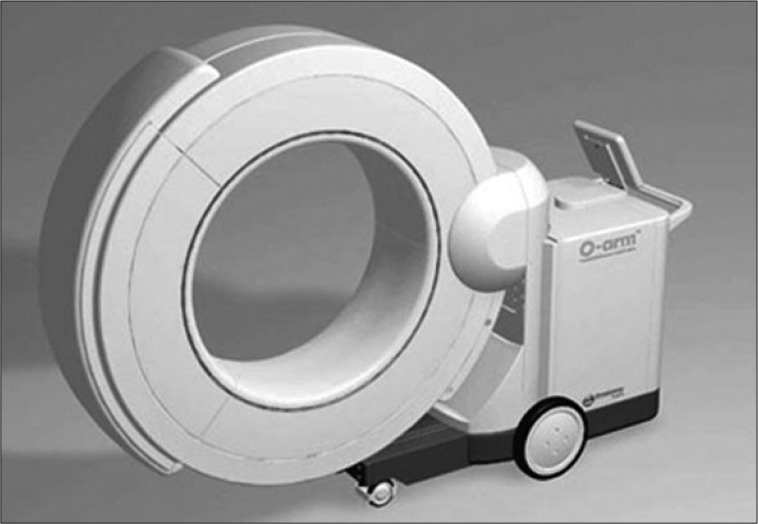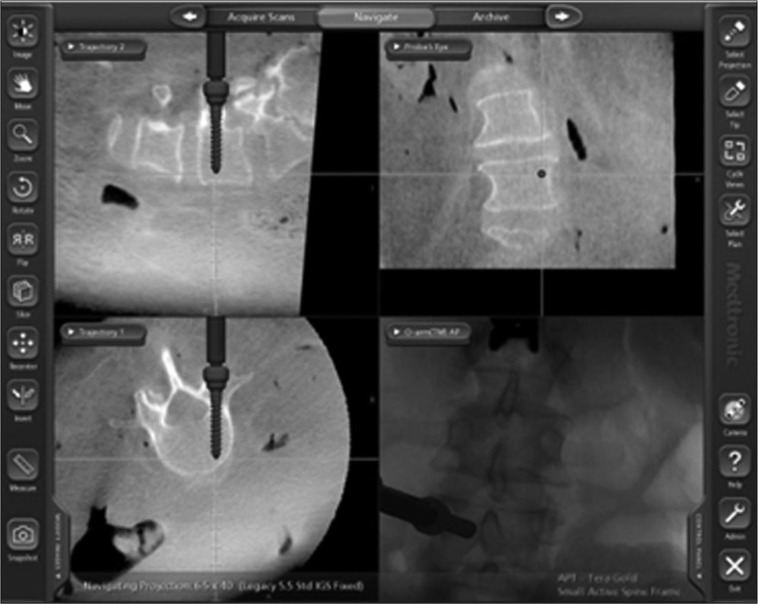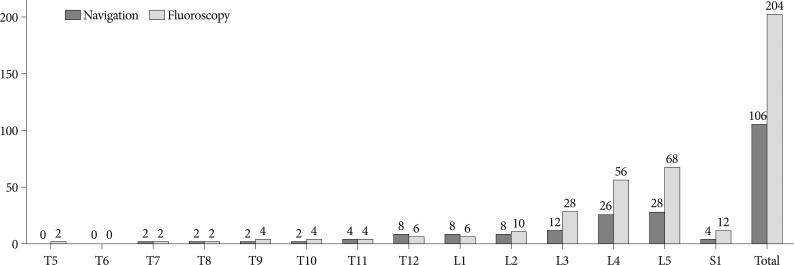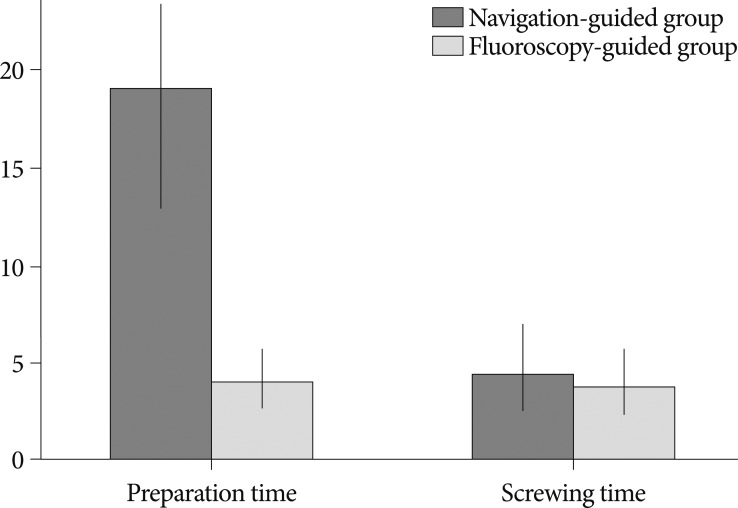J Korean Neurosurg Soc.
2012 Sep;52(3):204-209.
Accuracy and Safety in Pedicle Screw Placement in the Thoracic and Lumbar Spines : Comparison Study between Conventional C-Arm Fluoroscopy and Navigation Coupled with O-Arm(R) Guided Methods
- Affiliations
-
- 1Department of Neurosurgery, Seoul St. Mary's Hospital, The Catholic University of Korea, Seoul, Korea. nsdoc35@catholic.ac.kr
Abstract
OBJECTIVE
The authors performed a retrospective study to assess the accuracy and clinical benefits of a navigation coupled with O-arm(R) system guided method in the thoracic and lumbar spines by comparing with a C-arm fluoroscopy-guided method.
METHODS
Under the navigation guidance, 106 pedicle screws inserted from T7 to S1 in 24 patients, and using the fluoroscopy guidance, 204 pedicle screws from T5 to S1 in 45 patients. The position of screws within the pedicle was classified into four groups, from grade 0 (no violation cortex) to 3 (more than 4 mm violation). The location of violated pedicle cortex was also assessed. Intra-operative parameters including time required for preparation of screwing procedure, times for screwing and the number of X-ray shot were assessed in each group.
RESULTS
Grade 0 was observed in 186 (91.2%) screws of the fluoroscopy-guided group, and 99 (93.4%) of the navigation-guided group. Mean time required for inserting a screw was 3.8 minutes in the fluoroscopy-guided group, and 4.5 minutes in the navigation-guided group. Mean time required for preparation of screw placement was 4 minutes in the fluoroscopy-guided group, and 19 minutes in the navigation-guided group. The fluoroscopy-guided group required mean 8.9 times of X-ray shot for each screw placement.
CONCLUSION
The screw placement under the navigation-guidance coupled with O-arm(R) system appears to be more accurate and safer than that under the fluoroscopy guidance, although the preparation and screwing time for the navigation-guided surgery is longer than that for the fluoroscopy-guided surgery.
Keyword
MeSH Terms
Figure
Reference
-
1. Arand M, Hartwig E, Kinzl L, Gebhard F. Spinal navigation in tumor surgery of the thoracic spine : first clinical results. Clin Orthop Relat Res. 2002; 211–218. PMID: 12011712.2. Arand M, Schempf M, Hebold D, Teller S, Kinzl L, Gebhard F. [Precision of navigation-assisted surgery of the thoracic and lumbar spine]. Unfallchirurg. 2003; 106:899–906. PMID: 14634732.3. Austin MS, Vaccaro AR, Brislin B, Nachwalter R, Hilibrand AS, Albert TJ. Image-guided spine surgery : a cadaver study comparing conventional open laminoforaminotomy and two image-guided techniques for pedicle screw placement in posterolateral fusion and nonfusion models. Spine (Phila Pa 1976). 2002; 27:2503–2508. PMID: 12435982.4. Bolger C, Wigfield C. Image-guided surgery : applications to the cervical and thoracic spine and a review of the first 120 procedures. J Neurosurg. 2000; 92:175–180. PMID: 10763688.
Article5. Choi WW, Green BA, Levi AD. Computer-assisted fluoroscopic targeting system for pedicle screw insertion. Neurosurgery. 2000; 47:872–878. PMID: 11014427.
Article6. Diffey BL. The risk of skin cancer from occupational exposure to ultraviolet radiation in hospitals. Phys Med Biol. 1988; 33:1187–1193. PMID: 3194447.
Article7. Foley KT, Smith MM. Image-guided spine surgery. Neurosurg Clin N Am. 1996; 7:171–186. PMID: 8726434.
Article8. Fu TS, Wong CB, Tsai TT, Liang YC, Chen LH, Chen WJ. Pedicle screw insertion : computed tomography versus fluoroscopic image guidance. Int Orthop. 2008; 32:517–521. PMID: 17410363.9. Gertzbein SD, Robbins SE. Accuracy of pedicular screw placement in vivo. Spine (Phila Pa 1976). 1990; 15:11–14. PMID: 2326693.
Article10. Grob D, Magerl F, McGowan DP. Spinal pedicle fixation : reliability and validity of roentgenogram-based assessment and surgical factors on successful screw placement. Spine (Phila Pa 1976). 1990; 15:251. PMID: 2353267.11. Hallquist A, Hardell L, Degerman A, Wingren G, Boquist L. Medical diagnostic and therapeutic ionizing radiation and the risk for thyroid cancer : a case-control study. Eur J Cancer Prev. 1994; 3:259–267. PMID: 8061591.12. Hallquist A, Näsman A. Medical diagnostic X-ray radiation--an evaluation from medical records and dentist cards in a case-control study of thyroid cancer in the northern medical region of Sweden. Eur J Cancer Prev. 2001; 10:147–152. PMID: 11330455.
Article13. Jaiswal A, Shetty AP, Rajasekaran S. Role of intraoperative Iso-C based navigation in challenging spine trauma. Indian J Orthop. 2007; 41:312–317. PMID: 21139784.
Article14. Jones DP, Robertson PA, Lunt B, Jackson SA. Radiation exposure during fluoroscopically assisted pedicle screw insertion in the lumbar spine. Spine (Phila Pa 1976). 2000; 25:1538–1541. PMID: 10851103.
Article15. Kosmopoulos V, Schizas C. Pedicle screw placement accuracy : a meta-analysis. Spine (Phila Pa 1976). 2007; 32:E111–E120. PMID: 17268254.16. Linet MS, Kim KP, Miller DL, Kleinerman RA, Simon SL, Berrington de Gonzalez A. Historical review of occupational exposures and cancer risks in medical radiation workers. Radiat Res. 2010; 174:793–808. PMID: 21128805.
Article17. Magerl FP. Stabilization of the lower thoracic and lumbar spine with external skeletal fixation. Clin Orthop Relat Res. 1984; 125–141. PMID: 6478690.
Article18. Merloz P, Troccaz J, Vouaillat H, Vasile C, Tonetti J, Eid A, et al. Fluoroscopy-based navigation system in spine surgery. Proc Inst Mech Eng H. 2007; 221:813–820. PMID: 18019467.
Article19. Mirza SK, Wiggins GC, Kuntz C 4th, York JE, Bellabarba C, Knonodi MA, et al. Accuracy of thoracic vertebral body screw placement using standard fluoroscopy, fluoroscopic image guidance, and computed tomographic image guidance : a cadaver study. Spine (Phila Pa 1976). 2003; 28:402–413. PMID: 12590219.
Article20. Nolte LP, Slomczykowski MA, Berlemann U, Strauss MJ, Hofstetter R, Schlenzka D, et al. A new approach to computer-aided spine surgery : fluoroscopy-based surgical navigation. Eur Spine J. 2000; 9(Suppl 1):S78–S88. PMID: 10766062.21. Roessler K, Ungersboeck K, Dietrich W, Aichholzer M, Hittmeir K, Matula C, et al. Frameless stereotactic guided neurosurgery : clinical experience with an infrared based pointer device navigation system. Acta Neurochir (Wien). 1997; 139:551–559. PMID: 9248590.
Article22. Schonfeld SJ, Lee C, Berrington de González A. Medical exposure to radiation and thyroid cancer. Clin Oncol (R Coll Radiol). 2011; 23:244–250. PMID: 21296564.
Article23. Silbermann J, Riese F, Allam Y, Reichert T, Koeppert H, Gutberlet M. Computer tomography assessment of pedicle screw placement in lumbar and sacral spine : comparison between free-hand and O-arm based navigation techniques. Eur Spine J. 2011; 20:875–881. PMID: 21253780.
Article24. Simpson AK, Whang PG, Jonisch A, Haims A, Grauer JN. The radiation exposure associated with cervical and lumbar spine radiographs. J Spinal Disord Tech. 2008; 21:409–412. PMID: 18679095.
Article25. Singer CM, Baraff LJ, Benedict SH, Weiss EL, Singer BD. Exposure of emergency medicine personnel to ionizing radiation during cervical spine radiography. Ann Emerg Med. 1989; 18:822–825. PMID: 2757279.
Article26. Tian NF, Xu HZ. Image-guided pedicle screw insertion accuracy : a meta-analysis. Int Orthop. 2009; 33:895–903. PMID: 19421752.27. Tjardes T, Shafizadeh S, Rixen D, Paffrath T, Bouillon B, Steinhausen ES, et al. Image-guided spine surgery : state of the art and future directions. Eur Spine J. 2010; 19:25–45. PMID: 19763640.
Article28. van de Kraats EB, van Walsum T, Kendrick L, Noordhoek NJ, Niessen WJ. Accuracy evaluation of direct navigation with an isocentric 3D rotational X-ray system. Med Image Anal. 2006; 10:113–124. PMID: 16099196.
Article29. Weinstein JN, Spratt KF, Spengler D, Brick C, Reid S. Spinal pedicle fixation : reliability and validity of roentgenogram-based assessment and surgical factors on successful screw placement. Spine (Phila Pa 1976). 1988; 13:1012–1018. PMID: 3206294.
Article30. Xu R, Ebraheim NA, Ou Y, Yeasting RA. Anatomic considerations of pedicle screw placement in the thoracic spine. Roy-Camille technique versus open-lamina technique. Spine (Phila Pa 1976). 1998; 23:1065–1068. PMID: 9589548.
Article31. Yang YL, Zhou DS, He JL. Comparison of Isocentric C-Arm 3-Dimensional Navigation and Conventional Fluoroscopy for C1 Lateral Mass and C2 Pedicle Screw Placement for Atlantoaxial Instability. J Spinal Disord Tech. 2011; [Epub ahead of print].
Article
- Full Text Links
- Actions
-
Cited
- CITED
-
- Close
- Share
- Similar articles
-
- Accuracy of Pedicle Screw Placement in Scoliosis Surgery: A Comparison between Conventional Computed Tomography-Based and O-Arm-Based Navigation Techniques
- Accuracy of Pedicle Screw Insertion Using Fluoroscopy-Based Navigation-Assisted Surgery : Computed Tomography Postoperative Assessment in 96 Consecutive Patients
- Comparative Prospective Study Reporting Intraoperative Parameters, Pedicle Screw Perforation, and Radiation Exposure in Navigation-Guided versus Non-navigated Fluoroscopy-Assisted Minimal Invasive Transforaminal Lumbar Interbody Fusion
- Scoliosis Correction with Thoracic Pedicle Screws: Posteroanterior C-arm Rotation Method
- A Robot Arm-type Navigation System for Pedicle Screw Placement: A Feasibility Study





